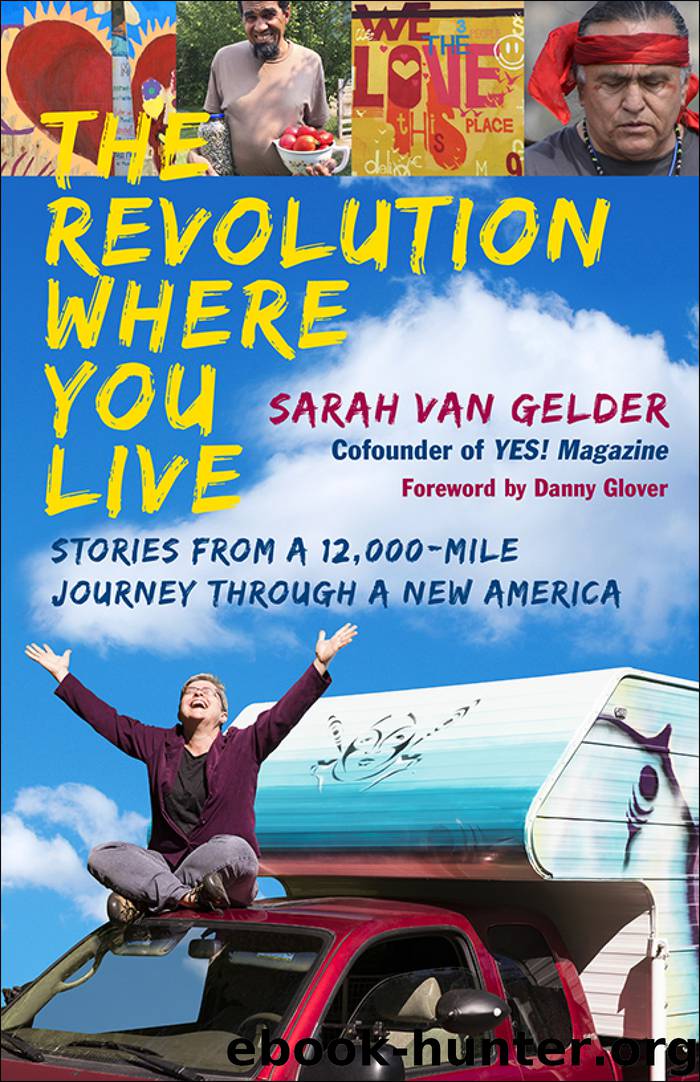The Revolution Where You Live by Sarah Van Gelder

Author:Sarah Van Gelder
Language: eng
Format: epub
Publisher: Berrett-Koehler Publishers
Published: 2017-04-14T16:00:00+00:00
Entering Whitesburg, Kentucky, you are greeted by these sculptures.
Smith ran me through the history of Appalshop. In 1969, during the War on Poverty, the federal Office of Economic Opportunity sent portable film cameras and editing gear out to a half dozen poor communities around the United States and held film workshops. Only two of those locations were rural; one of them was Whitesburg, Kentucky. The idea was to train young people to make films as a way to both improve their job prospects and tell their own stories, instead of being subjects in the stories outsiders wanted to tell.
The young people who showed up to do this work managed to continue creating films about their communities when the
Entering Whitesburg, Kentucky, you are greeted by these sculptures. federal money dried up. Ada Smith’s father, Henry Smith, was one of them. Henry Smith was one of eight children of a coal miner. Her mother, a filmmaker from Hazard, Kentucky, was also part of Appalshop’s early staff.
“I got off the school bus right in front of this building,” Ada told me.
What was it like to have Appalshop open in the midst of a quiet little coal town?
“Like a spaceship landed,” she replied.
Appalachia is famously poor, something the rest of the country got wind of when a 1964 presidential commission assigned to investigate the area issued a report of impoverished coal-mining families that shocked the nation’s conscience. The photos showed gaunt figures and malnourished children. Today, malnutrition remains a problem, but, ironically, it’s coupled with obesity caused by a diet high in fat, salt, and calories yet lacking nutrients.
Appalachia is reeling from the loss of jobs as the coal industry winds down. Mountains have been blown apart for the last seams of coal, rivers and creeks have been filled in with mining debris, and coal ash wastewater lakes sit behind unmaintained dams, threatening communities below. Plus, black lung disease has made a comeback since it was nearly eradicated. This is the legacy of the coal industry, which local politicians still claim is a source of prosperity.
According to author and sociologist Cynthia M. Duncan, Appalachia had intentionally been kept isolated and controlled.
“Historians have shown that the large Northeastern utilities and Midwestern utilities were pitting one small company against another. In the face of this bitter competition, coal operators tried to control everything about workers’ lives to keep their labor costs down,” Duncan told reporters from the PBS documentary series Frontline.1 “And part of controlling everything was to not educate people, to be in control of the ministers, the doctors, the stores . . . and to discourage workers’ participation in community life, making the workers dependent on the coal operators for everything about their livelihood and their community.”
Jobs in coal mining in Kentucky have fallen from 38,000 in 1983 to 17,000 30 years later, according to The Washington Post.2
But a sense persists that relying on others is shameful, and a stoic self-reliance is a source of pride.
As an adolescent growing up in that environment, Ada Smith was quite sure she wanted to leave.
Download
This site does not store any files on its server. We only index and link to content provided by other sites. Please contact the content providers to delete copyright contents if any and email us, we'll remove relevant links or contents immediately.
| Military | Political |
| Presidents & Heads of State | Religious |
| Rich & Famous | Royalty |
| Social Activists |
Waking Up in Heaven: A True Story of Brokenness, Heaven, and Life Again by McVea Crystal & Tresniowski Alex(37003)
Empire of the Sikhs by Patwant Singh(22172)
We're Going to Need More Wine by Gabrielle Union(18072)
Hans Sturm: A Soldier's Odyssey on the Eastern Front by Gordon Williamson(16623)
Leonardo da Vinci by Walter Isaacson(11902)
The Radium Girls by Kate Moore(10907)
Educated by Tara Westover(7061)
Tools of Titans by Timothy Ferriss(6946)
How to Be a Bawse: A Guide to Conquering Life by Lilly Singh(6693)
The Last Black Unicorn by Tiffany Haddish(5075)
Permanent Record by Edward Snowden(4997)
The Rise and Fall of Senator Joe McCarthy by James Cross Giblin(4843)
Promise Me, Dad by Joe Biden(4447)
The Wind in My Hair by Masih Alinejad(4424)
The Crown by Robert Lacey(4105)
A Higher Loyalty: Truth, Lies, and Leadership by James Comey(4032)
The Iron Duke by The Iron Duke(3639)
Joan of Arc by Mary Gordon(3258)
How to be Champion: My Autobiography by Sarah Millican(3186)
